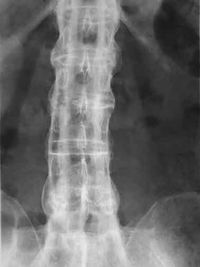Ankylosing spondylitis: Difference between revisions
No edit summary |
No edit summary |
||
| Line 39: | Line 39: | ||
==References== | ==References== | ||
<references/> | <references/> | ||
[[Category:Rheumatology]] | |||
Revision as of 18:40, 16 October 2015
Background
- Ankylosing spondylitis (AS) is a chronic inflammatory disease of the axial skeleton with variable involvement of other joints or even nonarticular structures.
- Ankylosing spondylitis is three times more common in males than females. It is usually diagnosed in young adults between the ages of 20 and 30 years.
- Often associated with other autoimmune disorders. About 90% of people with AS express the HLA-B27 genotype.
Clinical Features
- Spinal pain, particularly in the lower back, is usually the first and most common symptom of AS.
- Begins in early adulthood (before 45 years of age)
- Has a gradual onset
- Lasts longer than three months
- Is worse after rest (for example, in the morning) but improves with activity
- Can cause morning stiffness lasting more than 30 minutes
- Fatigue
- Can also be associated with anterior uvetitis, bowel ulcers and spinal fractures are 4 times more common in patients with AS
Differential Diagnosis
Lower Back Pain
- Spine related
- Acute ligamentous injury
- Acute muscle strain
- Disk herniation (Sciatica)
- Degenerative joint disease
- Spondylolithesis
- Epidural compression syndromes
- Thoracic and lumbar fractures and dislocations
- Cancer metastasis
- Spinal stenosis
- Transverse myelitis
- Vertebral osteomyelitis
- Ankylosing spondylitis
- Spondylolisthesis
- Discitis
- Spinal Infarct
- Renal disease
- Intra-abdominal
- Abdominal aortic aneurysm
- Ulcer perforation
- Retrocecal appendicitis
- Large bowel obstruction
- Pancreatitis
- Pelvic disease
- Other
Diagnosis
- There is no direct test for AS
- ESR, CRP can be elevated but not sensitive or specific for AS
- Xray lumbar/sacroiliac: The earliest changes in the sacroiliac joints shows erosions and sclerosis.
- Progression of the erosions leads to pseudo widening of the joint space and bony ankylosis AKA "Bamboo Spine." Often X-ray findings lag about 10 years from initial progression of disease.
- CBC
- Chem 10
- UA
- Genetic testing for HLA B27 ( > 90% of people with AS have this gene, though by it's self is not specific)
Management
- There is no cure for AS, although treatments and medications can reduce symptoms and pain
- Exercise and posture training should be part of the treatment program for everyone with AS
- NSAIDS
- Sulfasalazine can be used in people with peripheral arthritis. For axial involvement, evidence does not support sulfasalazine [1]. Lack of evidence for methotrexate [2] or steroids.
- Tumor necrosis factor-alpha blockers, such as the biologics etanercept, infliximab, golimumab and adalimumab, have shown good short-term effectiveness in the form of profound and sustained reduction in all clinical and laboratory measures of disease activity. Though long term management is currently being studied.
Disposition
- Often diagnosis will not be made in ER but if made in ER often can be discharged home with PMD F/U or Close Rheumatology f/u
See Also
External Links
References
- ↑ Chen J, Lin S, Liu C. Sulfasalazine for ankylosing spondylitis. Cochrane Database of Systematic Reviews 2014, Issue 11. Art. No.: CD004800. DOI: 10.1002/14651858.CD004800.pub3.
- ↑ Chen J, Veras MMS, Liu C, Lin J. Methotrexate for ankylosing spondylitis. Cochrane Database of Systematic Reviews 2013, Issue 2. Art. No.: CD004524. DOI: 10.1002/14651858.CD004524.pub4.



